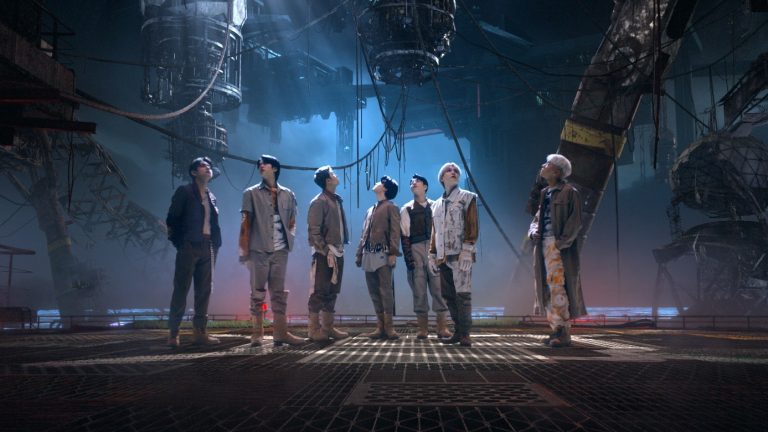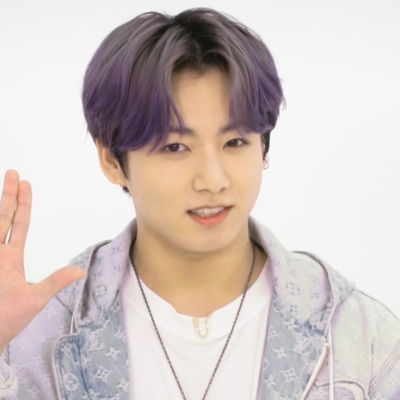My Universe: BTS & Coldplay’s Sci-Fi Music Video Explained
BTS and Coldplay go full sci-fi dystopia in the futuristic music video for "My Universe."

BTS and Coldplay went fully, gloriously sci-fi in the music video for their collaboration, “My Universe.” In the new music video, released at midnight on September 30th, the two bands exist in a futuristic reality where music is forbidden. In spite of the ban, and with the help of a space DJ, the groups come together for a high-energy, galaxy-spanning performance of their new song.
The “My Universe” music video/short film is directed by Dave Meyers, an American filmmaker best known for his commercials and music videos, which include MVs for artists Drake, Ed Sheeran, Pink, Normani, Ariana Grande, and many, many more. High-concept, genre-driven music videos are par for the course in the visually immersive world of K-pop, but are less common in western music videos, which (save for some outliers, like Janelle Monae’s funky, political sci-fi adventures) have more “grounded,” realistic aesthetics, even when they skew fantastical. A great example of the latter is Harry Styles’ “Adore You” video. Also directed by Meyers—it has a speculative fiction premise in which Styles has a literally blinding smile, falls in love with a fish, and is able to power his sailboat using the winds of his jarred yells, but keeps its visuals down to Earth to tell its fairy tale-like story.
“My Universe,” on the other hand, embraces the science fiction aesthetics of working class space operas like Space Sweepers or Guardians of the Galaxy, with some (and I mean this as a compliment) Zenon: Girl of the 21st Century thrown in for good measure.
Rebellion is a popular theme in the space opera subgenre, and it’s one that “My Universe” embraces. The video is set in an intergalactic future in a place known where all music is banned. Three different bands—BTS, Coldplay, and a fictional alien supergroup called Supernova7—who live on three different plans defy the ban to create music together via hologram. They are hunted by The Silencers, who enforce the no-music status quo.
Most importantly, the music video doesn’t prioritize either Coldplay or BTS’ worlds. While we may visit Coldplay’s dry, graffitied planet first, where we first meet BTS in their holographic forms, we also go to BTS’ industrial-dystopia home, where Coldplay visits as holograms. The music video’s best moment, in fact, comes when we follow a flickering, holographic V from Coldplay’s planet back to his own, where he—and, with him, the six other members—bloom into more tangible form.
The design and CGI for the video is impressive and varied, though a little too busy to fully appreciate the stunning outer space visuals, Tron-esque spaceships interiors, and alien planet-scapes. The video includes visual callbacks to the official lyric video for “My Universe,” which is beautifully designed to feature the multi-colored English and Korean-language lyrics zooming through space. The colors and premise are also reminiscent of the video serial that was part of BTS’ Muster Sowoozoo Concert in June. In the story, the seven members of BTS make their way across an alien landscape in a camper van, searching for a safe place to meet ARMY. While the Sowoozoo serial was much cozier and more chill than “My Universe” video, I’d love to hear some good head canon about how these videos exist in the same fictional universe.
What Does the “My Universe” Music Video Mean?
Both the “My Universe” song and music video have a pretty broad, easy-to-get-behind concept. The love song is about a relationship that transcends boundaries. Thematically, the idea of coming together across divisions or differences is particularly poignant when performed by bands from different sides of the planet. This is reinforced by the decision to include Korean-language lyrics in the collaboration. BTS has proven themselves more than capable of singing in English. Three of their latest hits—”Dynamite,” “Butter,” and “Permission to Dance”—are all sung fully in the English language by the Korean band. However, BTS and Coldplay chose to feature Korean-language elements as an integral part of the collaboration, emphasizing the multicultural nature of the song and its message.
The music video doubles down on the theme of people coming together despite distance and differences. In it, BTS and Coldplay (and, OK, alien supergroup Supernova 7) are excited to collaborate. Together, they make something beautiful and special that brings them joy despite the seemingly dismal worlds that surrounds them both. Here, the enemy is not difference, but a mysterious, totalitarian force that has banned all music. Personified by “The Silencers,” this antagonist can be broadly interpreted by the societal prejudices that can sometimes keep up apart, but also by a pandemic that has made the most basic rituals of togetherness more complicated. It doesn’t seem a coincidence that the fictional versions of BTS and Coldplay featured in this video are unable to be together in person. It’s a representation of the forced physical distance that has come to define much of the past few years. It’s why seeing the bands find a way, despite their harsh reality, to share a joyful experience so damn inspiring.
While the visuals of “My Universe” may be intentionally futuristic, the ability to play together across vast swathes of space is not. Just last week, Coldplay and BTS performed as part of the Global Citizen Live event. The bands were in two different countries—Coldplay in NYC, and BTS back home in Seoul—but came “together” on stage. The seven members of BTS were featured as holograms on a backdrop as Chris Martin sang both English and Korean-language parts of the song. (The Korean-language rap sections performed by Suga and J-Hope were pre-recorded.) Coldplay notably traveled to Korea to record “My Universe” during the pandemic.
“My Universe” Music Video Ending Explained
The breakout character from the “My Universe” music video is arguably DJ Lafrique, played by actress Joe Diao. DJ Lafrique is the character who is able to bring Coldplay and BTS together, across the universe. She is the most powerful figure featured in this story, and her rebellion comes at a high risk. At the end of the video, The Silencers find DJ Lafrique’s ship, which is making the intergalactic jam session possible. The Silencers’ power up their Death Star-like weapon in preparation to take out DJ Lafrique. However, BTS and Coldplay are able to buy her time by rocking out even more intensely (as you do); she powers up her hyperdrive and blips away before The Silencers can silence her forever.
The ending works for the video; it would be jarring to watch a music video featuring BTS that doesn’t end with a message of hope. The Korean band’s full name, Bangtan Sonyeondan, can be translated as “Bulletproof Boyscouts,” and the group has always seen it as one of their primary missions to act as a buffer between young people and the harsh stereotypes and pressures they face. While the group has always worked to be a balm in a harsh world, this has especially been the case since the outbreak of COVID, which has brought with it unprecedented mental health challenges. In the wake of the global crisis, BTS has worked to be a comfort to their global fandom, known as ARMY. When they released album “Be” in November 2020, member Jin said during the accompanying press conference: “Our goal with the music on ‘BE’ is that it can be a comfort to a lot of people … If many people can relate to it, I will be really thankful.”
What did you think of “My Universe”‘s science fiction concept? Let us know in the comments below.


